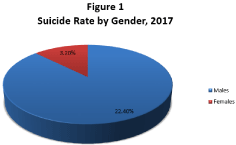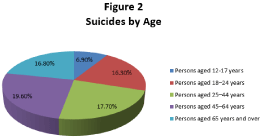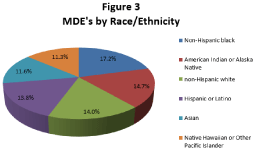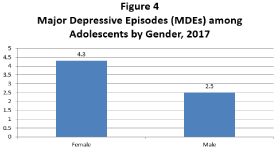Abstract
Approximately fifty (50) members representing the U.S. Department of Health and Human Services (HHS) in addition to other Federal departments were assembled to create the Healthy People 2020 Federal Interagency Workgroup. The outcome of this assembly was the identification of Leading Health Indicators (LHIs) in the different domains of healthcare. The framework for developing the LHIs was chosen and systemized using the conceptual framework of the Health Determinants and Health Outcomes by Life Stages. One advantage of this framework is that it presents opportunities to foster health and advance quality of life for all Americans. This framework provides a mechanism to identify individual and societal determinants that influence public health and impact health disparities beginning in infancy and progressing through old age. For the field of mental health, suicide and adolescent major depressive episodes were selected as the LHIs as both of these conditions showed vary high rates and disparities among gender, age, and geography to name a few.
Keywords: 2020 Healthy People; Baselines; Major Depressive Episodes; Suicide; Targets
Introduction
Approximately fifty (50) members representing the U.S. Department of Health and Human Services (HHS) in addition to other Federal departments were assembled to create the Healthy People 2020 Federal Interagency Workgroup. The charge of this workgroup was to develop the final set of Leading Health Indicators (LHI) for mental health stemming from Healthy People 2020 objectives.
The workgroup began with the desire to align the recommendations from the Institute of Medicine of the National Academy of Sciences and the Secretary’s Advisory Committee on National Health Promotion and Disease Prevention Objectives while developing and advancing the final set of LHIs. The workgroup took into consideration indicators published by the National Prevention Strategy as mandated by the Affordable Care Act. Alignment among all of the prevention initiatives within DHHS and other Federal agencies was a key priority.
The framework for developing the Healthy People 2020 LHIs was chosen and systemized using the conceptual framework of the Health Determinants and Health Outcomes by Life Stages. One advantage of this framework is that it presents opportunities to foster health and advance quality of life for all Americans. This framework provides a mechanism to identify individual and societal determinants that influence public health and impact health disparities beginning in infancy and progressing through old age.
Biological, economic, environmental, and social elements, individually coupled with their interrelationships, impact the factors of health and health disparities as reflected in the LHIs. Focusing on these elements is strategic to advancing population health while reducing and hopefully abolishing health disparities.
Risk factors differ across life spans effecting individual health and disease. LHIs monitor and show these effects at different points in the individual’s life cycle. Intervening with these risk factors at the appropriate time can diminish their effect and improve health.
The purpose of this article is to examine suicide and major depressive episodes as LHIs and the data that supports the decision to select them as LHIs. It is beyond the scope of this paper to explore interventions that will enable practitioners to achieve the targets set by the LHIs.
Background
In the United States, mental illness ranks among the most prevalent of all diseases. The prevalence of mental disorders is the most frequent reason for disability. The Centers for Disease Control and Prevention (CDC) report that one in four adults experienced a mental health disorder with anxiety and depression being the most reported [1]. At the same time one in seventeen experienced a serious mental illness. Major depressive episodes and anxiety disorders such as PTSD, OCD, and Panic Disorder with Agoraphobia can be severe enough to be considered a serious mental illness. Psychiatrists in community mental health consider major depressive episodes to be a disorder whose symptoms impact functioning along 4 areas: Activities of Daily Living, Adaptation to Change, Interpersonal Functioning, and Concentration/Task Performance/Pace. Coincidentally, or not, functioning in these four areas make up the basis for evaluating disability and awarding of Social Security and Medicaid Disability. Children and adolescents are not immune from mental health disorders, the most common being Attention Deficit Hyperactivity Disorder (ADHD). CDC reports the following statistics:
• 9.4% of children aged 2-17 years (approximately 6.1 million) have received an ADHD diagnosis [2];
• 7.4% of children aged 3-17 years (approximately 4.5 million) have a diagnosed behavior problem [3];
• 7.1% of children aged 3-17 years (approximately 4.4 million) have diagnosed anxiety [3]; and
• 3.2% of children aged 3-17 years (approximately 1.9 million) have diagnosed depression [3].
Furthermore, there may be some comorbidity such as:
• Having another disorder is most common in children with depression: about 3 in 4 children aged 3-17 years with depression also have anxiety (73.8%) and almost 1 in 2 have behavior problems (47.2%) [3];
• For children aged 3-17 years with anxiety, more than 1 in 3 also have behavior problems (37.9%) and about 1 in 3 also have depression (32.3%) [3]; and
• For children aged 3-17 years with behavior problems, more than 1 in 3 also have anxiety (36.6%) and about 1 in 5 also have depression (20.3%) [3].
Vital to a person’s welfare, a salubrious family, social interactions, and the aptitude to a full and positive life is sound mental health. Both children and adults with untreated mental disorders pose a risk for unhealthy and damaging behaviors such as; alcohol or drug abuse, violence, and suicide. CDC reports that in 2016, nearly 45,000 Americans age 10 or older died by suicide making it the 10th leading cause of death [4]. Interestingly, suicide rates vary greatly among U.S. states. For example, in Washington, D.C. 6.9 per 100,000 residents per year died from suicide while 29.2 per 100,000 residents in Montana died from suicide [4].
Rarely is there a single factor attributable to suicide. Research shows that more than 50% of deaths due to suicide did not have a known diagnosed mental health condition at the time of death [4]. Research shows that frequent problems associated with suicide include: substance misuse/abuse, employment, financial, various types of loss, physical health problems, legal, housing, or relationship issues [4]. The most common method employed in suicide was the use of firearms [4].
Physical health is strongly impacted by mental health disorders and in particular chronic diseases such as cancer, cardiovascular disease and diabetes. Detrimental and enduring effects on economic and psychosocial issues can be observed in individuals with mental health disorders as well as on their families, schools, places of employment and the community they reside in.
Fortuitously, many mental health disorders can be treated effectively. Prompt diagnosis and treatment can reduce the liability of mental health disorders and the impact on related chronic diseases. It becomes clear that gauging and attending to mental health is imperative to ensuring wholesome and longer lives.
Healthcare metrics may be defined as a quantitative measurement used for gauging, comparing and tracking the specific treatment of a disease or condition. Every part of healthcare has explicit performance metrics that are monitored to assess how a patients’ disease/condition is responding to treatment. To be useful, healthcare metrics should be assessed against established benchmarks or objectives. By developing healthcare objectives, an indispensable context is ascertained for the values developed for the metric and allows clinicians to better act on the information they are observing. Context allows healthcare metrics to influence treatment decisions. Healthcare uses two types of metric indicators. One is referred to as performance indicators which are general indicators such as morbidity and mortality rates used by CDC and the second is Leading Health Indicators as used by Health People 2020 for specific diseases/conditions. LHI’s target specific diseases/ conditions that are considered to be the most imperative to the health and quality of life of people.
Some metrics in healthcare can be easily identified as in the case with an elevated blood pressure or an elevated glucose level. However, Leading Health Indicators for Mental Health are more of a challenge as the indicators are based on reported behaviors or attempts to quantify the indicators through the use of questionnaires. That said, two of the LHIs in mental health are:
• Suicide; and
• Adolescents with a major depressive episode in the past 12 months.
The relationship between physical health and mental health has been well documented. Research studies show a strong association between mental health disorders, especially depression, and chronic diseases including hypertension, stroke, heart disease, [5,6] and cancer [7,8]. An interesting finding of these studies shows mental health disorders precede chronic diseases, which in turn, the chronic diseases strengthen mental health disorders. This observed finding affects the incidence, peril, management, advancement and LHI outcomes. The dance between mental health and physical health can lead to a spiral of declining health. While an increased awareness of physical health, especially chronic diseases, is evident in the public, there is a lower level of awareness of mental health disorders and the stigma of a mental health disorder prevails. Mental health and physical health must be treated concurrently to demonstrate marked improvement in the 2020 Health People indicators.
Life Stages and Determinants
Understanding how mental health develops during an individual’s lifespan is ironically based on knowledge of what constitutes mental illness, as the etiology of mental health is less understood than that of mental illness. Research funded by the National Institute on Mental Health and other funding agencies have recently been examining mental health and mental health promotion programs. The anticipation that additional mental health indicators may emerge as a result of this research, and advance measurement of mental health, for use in better understanding of mental health. Further insight into mental health problems and mental disorders continues, as issues are understood at a greater depth. The preponderance of mental health problems and mental disorders advance along a trajectory. Some problems/disorders progress slowly with increasing incidence and gravity of symptoms with no distinct beginning and ending points. For example, certain drug ab/use progress gradually over time and the nature of others such as schizophrenia and depression can be episodic. There are some disorders that build up rapidly such as in the case of a major trigger event. These trigger events may trigger depression, anxiety, or post-traumatic stress distress in individuals who would not encounter a mental health problem.
Children and adolescents
It is reported that approximately 20% of U.S. children and adolescents experience mental health disorders during their lifetime. Frequently anxiety disorders emerge by age 6, behavior disorders by age 11, mood disorders by age 13, and substance use disorders by age fifteen [9]. Research shows that 15% of high school students have seriously considered suicide, and 7% have attempted to take their own life [10]. If unaddressed mental health disorders among children and adolescents can lead to school failure, alcohol or other drug abuse, family dissonance, violence, and suicide [11].
Adults
An estimate of U.S. adults believed to be in peak mental health is only seventeen percent [1]. Furthermore, estimates are that 26% of Americans are living with a mental health disorder in any given year and over the span of their lifetime 46% will experience a disorder [1]. Postpartum depression in women reported to approach fifteen percent [1].
Older adults
Aging presents new challenges to individuals. Residents of nursing homes between the ages of 65 to 74 years of age report an 18.7% rate of mental illness [1]. Additionally, people over the age of 85 years of age have reported a 23.5% rate of mental illness [1]. Chronic diseases become more pronounced as do mental health disorders. For example, Alzheimer’s has become the 10th leading cause of death in the United States. Alzheimer’s progresses to be the 6th leading cause of death among American adults and the 5th leading cause of death for adults over the age of 65 years [12].
Determinants of mental health
Mental health is difficult to define and measure. A number of definitions have been proposed over the years however there has not been a universally accepted definition. One reason may be is that there are numerous determinants affecting mental health. To complicate the issue many of these determinants are genetic in nature, environmental and originate in disciplines other than healthcare. For example, genetics is a factor in race/ethnicity, gender and sexual orientation. Environment is a factor in geographic location and educational opportunities. Economics plays a vital role as a determinant in employment opportunities, income level, housing as well as educational level. Social conditions determinants impact family and community dynamics as well as interpersonal dynamics. And many of these determinants are not affected by one domain but rather multiple domains. Risk factors in each domain can impact mental health and when multiple risk factors are present mental health problems present themselves.
Latest Data
Suicide
The Healthy People 2020 objective, MHMD-1, follows the suicide rate for the total U.S. population. The Healthy People 2020 target is set at 10.2 suicides per 100,000 age adjusted population using 2007 as the baseline and would show a 10% improvement. In the ten year span between 2007 and 2017 suicide rates increased by 23.9%, going from 11.3% to 14.0% per 100,000 age adjusted population.
Examining suicide rates by racial/ethnic groups showed Asian or Pacific Islanders experienced the lowest suicide rate at 6.6 per 100,000 age adjusted population. Comparing this rate to other racial/ethnic groups a disparity is observed. The suicide rates for other racial/ ethnic groups are as follow:
• 17.8 suicides per 100,000 population among non-Hispanic white persons; more than 2.5 times the Asian or Pacific Islander group rate;
• 13.5 suicides per 100,000 population among American Indian or Alaska Native persons; twice the Asian or Pacific Islander group rate;
• 6.9 suicides per 100,000 population among non-Hispanic black persons; not statistically different from the Asian or Pacific Islander group rate; and
• 6.9 suicides per 100,000 population among Hispanic or Latino persons; not statistically different from the Asian or Pacific Islander group rate.
When examined by gender, the data show females have a 6.1% suicide rate compared to males with a 22.4% rate per 100,000 ageadjusted population. Figure 1 shows males having a rate that is 3.5 times greater than that for females.

Figure 1:
Age groups also showed variation in suicide rates (Figure 2). For example:

Figure 2:
• Among persons aged 12-17 years, 6.9 suicides per 100,000 population;
• Among persons aged 18-24 years, 16.3 suicides per 100,000 population;
• Among persons aged 25-44 years, 17.7 suicides per 100,000 population;
• Among persons aged 45-64 years, 19.6 suicides per 100,000 population; and
• Among persons aged 65 years and over, 16.8 suicides per 100,000 population.
Lower suicide rates were reported for persons living in a metropolitan area when compared to non-metropolitan areas. The rate for metropolitan areas was 13.2% and for non-metropolitan areas, it was 19.1% per 100,000 age adjusted population. This is a 44.7% higher rate for non-metropolitan areas.
Endnote
All data in the section is available at Healthy People.gov [13].
Adolescents
One of Health People 2020 objectives is to track and decrease Major Depressive Episodes (MDE) in adolescents. The specifics of the objective are to track adolescents aged 12-17 years who experienced a major depressive episode in the past 12 months. The target that has been set is 7.5%, which is a 10% decrease over the 2008 baseline. Between the years of 2008 and 2017 the percentage of adolescents ranging in age between 12-17 years, experiencing an MDE in the past 12 months, increased from 8.3% to 13.3%, which is a 60.2% increase.
Examining MDE’ in the past 12 months a number of groups had the lowest MDE rates including non-Hispanic blacks, males, and adolescents aged 12-13 years (Figure 3). A number of disparities were observed when viewed against the lowest rate of 9.5% by the Non- Hispanic black adolescents aged 12-17 years. Other racial/ethnic rates are as follow:

Figure 3:
• 17.2% of adolescents who identify with 2 or more races were 81.7% higher than Non-Hispanic black adolescents aged 12-17 years;
• 14.7% of American Indian or Alaska Native adolescents were 55.2% higher than Non-Hispanic black adolescents aged 12-17 years;
• 14.0% of non-Hispanic white adolescents were 47.3% higher than Non-Hispanic black adolescents aged 12-17 years;
• 13.8% of Hispanic or Latino adolescents were 45.2% higher than Non-Hispanic black adolescents aged 12-17 years;
• 11.6% of Asian adolescents were not significantly different than Non-Hispanic black adolescents aged 12-17 years; and
• 11.3% of Native Hawaiian or Other Pacific Islander adolescents were not significantly different than Non-Hispanic black adolescents aged 12-17 years.
When examined by gender, the data show females have a 20% MDE rate compared to males with a 6.8% rate per 100,000 age adjusted population. Figure 4 shows females having a rate that is 2.5 times greater than that for males.

Figure 4: Data source: National Survey on Drug Use and Health (NSDUH), SAMHSA.
Adolescents aged 12-13 years showed the lowest rate of an MDE in the past 12 months, and that was 6.9%. The rates for other age groups were:
• 14.5% of adolescents aged 14-15 years; more than twice the 12-13 age group; and
• 17.7% of adolescents aged 16-17 years; more than 2.5 times the 12-13 age group rates.
Endnote
All data in the section is available at Healthy People.gov [13].
Discussion
There are numerous mental health and mental disorders showing rates worthy of attention. While any number of these disorders could have been chosen by Health People 2020 as LHIs, suicide and major depressive episodes in adolescents were selected because of their exceptionally high rates, the disparities seen when the data was stratified by gender, age, geography, etc. and in conjunction with the Institute of Medicine of the National Academy of Sciences and the Secretary’s Advisory Committee on National Health Promotion and Disease Prevention Objectives. In addition, the workgroup took into consideration indicators published by the National Prevention Strategy as mandated by the Affordable Care Act.
Data show suicide rates increased by 23.9% in the ten year span between 2007 and 2017 and data stratification indicate the rates vary geographically as well as by gender, race/ethnicity and age making this a strong contender for an LHI. Supporting the LHI selection, rural areas show higher suicide rates than large urban centers, data on males show they have died from suicide 3.5 times greater than females and non-Hispanic white persons died from suicide 2.5 times more than the baseline of Asian or Pacific Islander group. The suicide data show suicide does not have a single attributable factor and factors vary from personal to societal factors. Personal factors such as substance misuse/abuse, employment difficulties, and loss or relationship issues are known reasons. Societal reasons include disparities, discrimination, and lack of employment opportunities.
Major depressive episodes were selected as an LHI among adolescents because there was an increase of 60.2% between the years of 2008 and 2017. Examining the data closer, the percentage of adolescents ranging in age between 12-17 years, who experienced an MDE in the past 12 months reveal some disparities among race/ ethnic groups and age groups. Non-Hispanic black adolescents showed the lowest rate of 9.5% and the group with the highest rate was adolescents who identify with 2 or more races showing a rate that is 81.7% higher than the Non-Hispanic black group. Adding to the justification for selecting adolescent major depressive episodes as an LHI, data show that females were 2.5 times more likely to experience a major depressive episode than males. The reason for this disparity is unknown.
While LHIs highlight the problem they do not necessarily offer insight into all of the factors attributable to the issue or opportunities to address the high rates. For example, access to care has been a historical problem in all of healthcare and may be more pronounced in mental health. Rural areas in particular suffer from access to care issues and if this issue was addressed it may help reduce the rates and achieve the targets. In summary the metrics for the LHIs provide a baseline and targets for clinicians to address suicide and major depressive episodes and for researchers to continue to develop treatments/therapies that will support achieving the set targets.
References
- Reeves WC, Strine TW, Pratt LA, Thompson W, Ahluwalia I, Dhingra SS, et al. Mental illness surveillance among adults in the United States. MMWR. 2011; 60: 1-32.
- Danielson ML, Bitsko RH, Ghandour RM, Holbrook JR, Blumberg SJ, Kogan MD. Prevalence of parent-reported ADHD diagnosis and associated treatment among U.S. children and adolescents. Journal of Clinical Child and Adolescent Psychology. 2018; 47: 199-212.
- Ghandour RM, Sherman LJ, Vladutiu CJ, Ali MM, Lynch SE, Bitsko RH, et al. Prevalence and treatment of depression, anxiety, and conduct problems in U.S. children. J Pediatrics. 2019; 206: 256-267.
- Centers for Disease Control and Prevention. Suicide rates rising across the U.S.
- Jonas BS, Franks P, Ingram DD. Are symptoms of anxiety and depression risk factors for hypertension? Arch Fam Med. 1997; 6: 43-49.
- Jonas BS, Mussolino ME. Symptoms of depression as a prospective risk factor for stroke. Psychosom Med. 2000; 62: 463-471.
- Division of Adult and Community Health, Centers for Disease Control and Prevention. Public Health Action Plan to Integrate Mental Health Promotion and Mental Illness Prevention with Chronic Disease Prevention, 2011-2015.
- Chapman DP, Perry GS, Strine TW. The vital link between chronic disease and depressive disorders. Preventing Chronic Disease. Atlanta, GA: Centers for Disease Control and Prevention; 2005.
- Merikangas KR, He J, Burstein M, et al. Lifetime prevalence of mental disorders in U.S. adolescents: Results from the National Comorbidity Study- Adolescent Supplement (NCS-A). J Am Acad Child Adolesc Psychiatry. 2010; 49: 980-989.
- Eaton DK, Kann L, Kinchen S, Shanklin S, Ross J, Hawkins J, et al. Youth risk behavior surveillance-United States, 2007. Surveillance summaries, June 6. MMWR. 2008; 57: 1-131.
- MedlinePlus, National Library of Medicine, National Institutes of Health. Child Mental Health. Bethesda, MD: 2011.
- Healthy Aging Program, Centers for Disease Control and Prevention. Alzheimer’s disease. Atlanta, GA: 2011.
- Healthy People 2020. Healthy People.gov-mental health. 2019.
